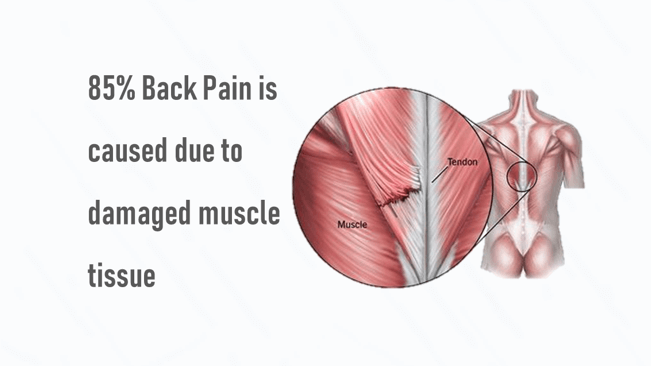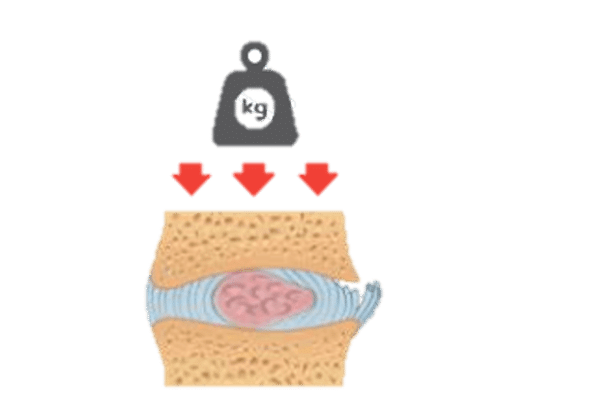Request Appointment
Enter your details and we will be in touch with you shortly;
Or call
8655885566
between 8 am and 8 pm.

Damage to soft muscle tissues in the back due to overuse

The common symptoms of lower back muscle strain typically include the following:
 Professional diagnosis required
Professional diagnosis required Chronic, can last for years
Chronic, can last for years Treatable with 4 weeks of QI Spine Therapy
Treatable with 4 weeks of QI Spine TherapyLower back muscle strain is the most common cause of low back pain. The lower back is more susceptible to muscle strain and sprain as it supports the weight of the upper body and is involved in twisting, moving, and bending.
Lower muscle strain is caused when muscle fibers are abnormally stretched or torn while a lumbar sprain is caused when ligaments are torn. Both of them result from a sudden injury or develops gradually due to overuse.
As the muscles are torn due to overstretching, they become weak and may not be able to hold the bones of your spinal column. The spine becomes less stable and results in low back pain.
Some of the lower back muscle strain causes are as follows:
 Professional diagnosis required
Professional diagnosis required Chronic, can last for years
Chronic, can last for years Treatable with 4 weeks of QI Spine Therapy
Treatable with 4 weeks of QI Spine TherapyLower back muscle strain can be painful but it heals mostly on its own with time. The initial lower back muscle strain treatment consists of self-care measures listed below that can be done at home.
With the help of DSA, the spine specialist will recommend lower back muscle strain treatment aimed to target the weak and affected muscles. After an in-depth evaluation, the spine specialist may suggest physical therapy and medical movements specific to reduce pain and also strengthen your weaker muscles. You may also be advised a few movements or exercises to continue even after recovery to maintain good spine health.
You can prevent lower back muscle strain with the help of a few tips mentioned below: -
You should seek immediate medical care if you face any of the below symptoms along with back pain: -
 Professional diagnosis required
Professional diagnosis required Chronic, can last for years
Chronic, can last for years Treatable with 4 weeks of QI Spine Therapy
Treatable with 4 weeks of QI Spine Therapy Professional diagnosis required
Professional diagnosis required Chronic, can last for years
Chronic, can last for years Treatable with 4 weeks of QI Spine Therapy
Treatable with 4 weeks of QI Spine TherapyYour physician shall check your medical history and also conduct a physical examination to diagnose muscle strain in the lower back.
Medical history includes detailed information about current symptoms, their onset, exercise levels, sleep habits, and previous medical problems.
Imaging tests are usually not required unless pain persists for over 6 weeks. If needed, some imaging tests such as x-rays, CT scans, MRI may be recommended.
A spine specialist will check your past medical records. The physical examination will be done to check your range of motion and flexibility in the low back as well as in the hip, pelvic, or hamstring muscles. Nerve root irritation may also be assessed.
A DSA (Digital Spine Analysis) test may be done to find out the specific muscle that has been injured or affected.
 Professional diagnosis required
Professional diagnosis required Chronic, can last for years
Chronic, can last for years Treatable with 4 weeks of QI Spine Therapy
Treatable with 4 weeks of QI Spine Therapy


Have a question?
Ask our spine specialists
Who is a QI Spine Specialist?
A QI Spine Specialist is a medical expert with

Dr. Nidhi Sanghvi Shah

Dr. Shital Gaikwad

Dr. Richa Bhatia
9000 hours
of specialisation in treating back and neck conditions
32 hours
of spine physiotherapy specialisation methods in McKenzie concepts, Kinetic control, Neurodynamic solutions, Mulligan’s concepts
500 hours
and 6 months of QI Spine specialisation courses
Usually, muscle strain resolves within 4-6 weeks mostly, however, some severe muscle strain can take months to heal.
Massage therapy helps in relaxing tight muscles and increases circulation to promote healing. Massaging may increase range of motion and also helps in relieving pain.
The best sleeping position is to lie flat on your back, keep a small pillow under your knees to keep your spine in a neutral position.
Few signs of lower back muscle strain include dull, achy low back pain, pain that intensifies with movement, local tenderness, and pain that is contained in the low back only. Muscles may feel sore, tight, or achy.